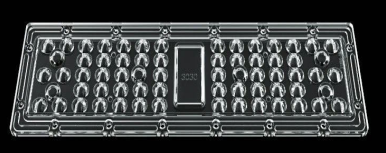LED street light is an important part of road lighting, also shows a city's level of modernization and cultural taste.
Lens is an indispensable accessory for street lights. It can not only gather divergent light sources together, so that light can be distributed in a regular and controllable way in space, but also perfectly avoid light waste so as to improve light energy utilization rate. High quality street light lens can also reduce glare and make the light softer.

1.How to choose the light pattern of LED street light?
LED often needs to go through lens, reflective hood and other secondary optical design to achieve the design effect.Depending on the combination of LED and matching lens, there will be different patterns, such as round spot, oval spot and rectangular spot.
At present, the rectangular light spot is mainly required for LED street lamps. The rectangular light spot has a strong ability to concentrate light, and the light after the concentrated light shines uniformly on the road, so that the light can be used to a large extent. It is generally used in the road of motor vehicles.
2.The beam angle of street light.
Different roads require different optical requirements.For example, in the expressway, trunk road, trunk road, branch road, courtyard district and other places, different angles should be considered to meet the light needs of the passing crowd.
3.Material of Street Light.
Common street lamp lens materials are glass lens,optical PC lens and optical PMMA lens.
Glass lens, mainly used for COB light source, its transmittance is generally 92-94%, high temperature resistance 500℃.
Due to its high temperature resistance and high penetrability, optical parameters can be selected by oneself, but its large quality and fragile also make its use scope limited.
Optical PC lens, mainly used for SMD light source, its transmittance is generally between 88-92%, temperature resistance 120℃.
Optical PMMA lens, mainly used for SMD light source, its transmittance is generally 92-94%, temperature resistance 70℃.
New materials PC lens and PMMA lens, both of which are optical plastic materials, can be molded through plastic and extrusion, with high productivity and low material cost. Once used, they show significant advantages in the market.
Post time: Sep-24-2022





